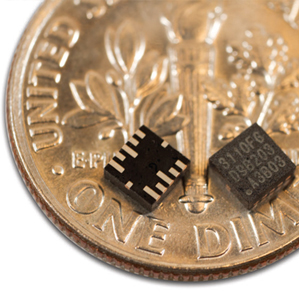A New Chip Could Add Motion Sensing to Clothing
A company called mCube has made a new kind of accelerometer, the device that senses motion from inside a smartphone or fitness monitor. The component is small and cheap enough to lead to smart electronics in clothing and sports equipment.

The new accelerometers are a millimeter across, less than half the size of conventional ones. The company says they are more accurate, more power-efficient, and cheaper to make. “You could embed it into your clothing so that you don’t even know it’s there,” says mCube CEO Ben Lee. “You could put them in your golf shirt and pants, so immediately after you swing you can get an analysis on your smartphone.”
Accelerometers are usually made of two chips: a mechanical device that detects movement, and a microchip that makes sense of the signal from the first chip. By integrating those components on a single chip, mCube has not only reduced the size of the device but achieved a higher-quality signal. In fact, the company says its new accelerometer is sensitive enough to replace the gyroscope in a smartphone. This could perhaps bring sophisticated motion-sensing capabilities to even the cheapest smartphones, some of which lack gyroscopes.
Nearly 70 million of mCube’s sensors have already been shipped to electronics manufacturers in China for use in smartphones. The company recently raised $37 million in venture funding, and it has plans to scale up production and expand to other markets.
Mike Rosa, a project manager at Applied Materials, which makes manufacturing equipment for electronics companies that compete with mCube, says its customers are also interested in integrated, single-chip accelerometers. Rosa says Applied Materials is, in fact, developing a process for making such chips using the latest materials, including silicon germanium.
Embedding motion sensors in clothing, mCube’s long-term goal, would require better ways of powering the devices and having them communicate. But several experimental options for energy harvesting or wireless charging might eventually make that possible (see “A Batteryless Sensor Chip for the Internet of Things” and “Mobile Gadgets That Connect to Wi-Fi without a Battery”).
Keep Reading
Most Popular
Large language models can do jaw-dropping things. But nobody knows exactly why.
And that's a problem. Figuring it out is one of the biggest scientific puzzles of our time and a crucial step towards controlling more powerful future models.
How scientists traced a mysterious covid case back to six toilets
When wastewater surveillance turns into a hunt for a single infected individual, the ethics get tricky.
The problem with plug-in hybrids? Their drivers.
Plug-in hybrids are often sold as a transition to EVs, but new data from Europe shows we’re still underestimating the emissions they produce.
Google DeepMind’s new generative model makes Super Mario–like games from scratch
Genie learns how to control games by watching hours and hours of video. It could help train next-gen robots too.
Stay connected
Get the latest updates from
MIT Technology Review
Discover special offers, top stories, upcoming events, and more.